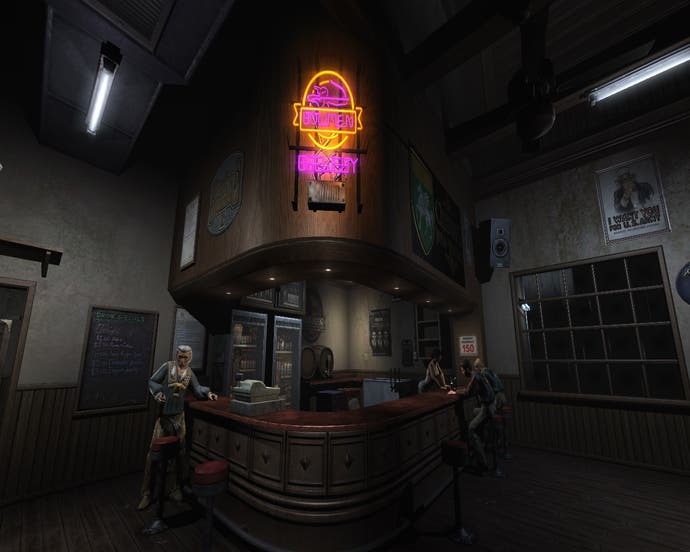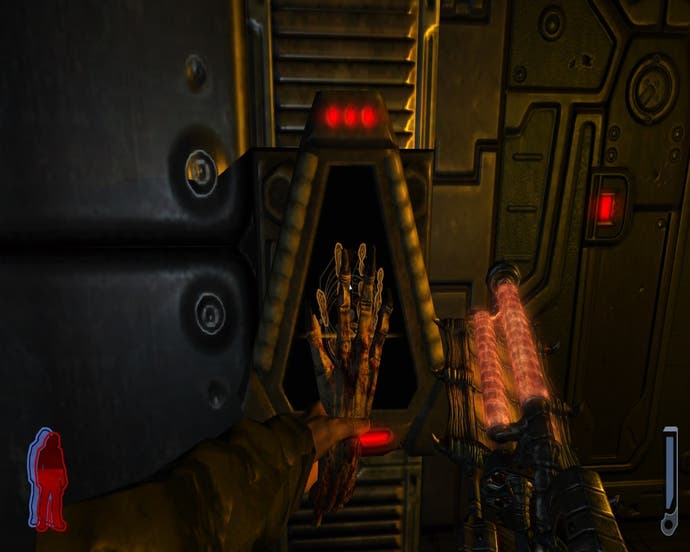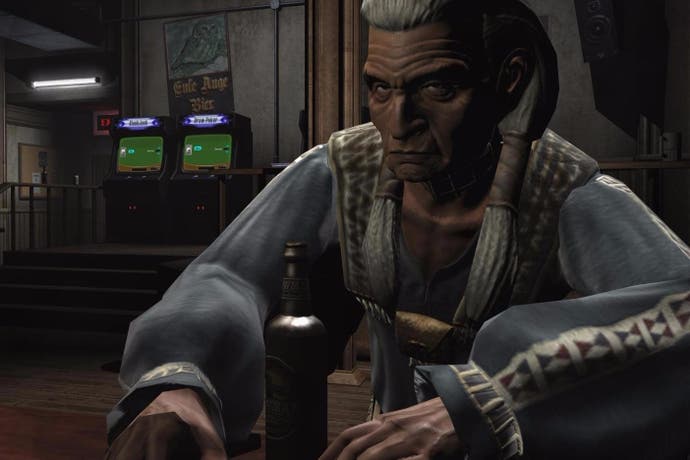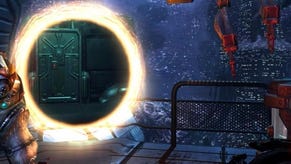Prey was a flawed FPS with ideas worth remembering
This wasn't a triumph.
What a curious legacy Prey has left behind. This 'franchise' (imagine airquotes the size of skyscrapers) has been in existence for two decades, resulting in one single game. There are stormtroopers with better hit rates than that. In fact, up to this point Prey is probably better known for the games that never happened than the one which eventually did.
The original Prey took a decade to develop, going through numerous iterations and engines before stumbling onto shelves in 2006. There was supposed to be a sequel, and it looked fantastic. A conceptual head-on collision between Mirror's Edge and Blade Runner, Prey 2 was set in an open-world, neon-soaked alien megacity. It's an idea that still excites me, not that I'm still mourning it cancellation. It's only been, what, six years? *sniff*.
As for the game Human Head Studios produced, frankly, I've barely thought about it in the last decade. I remember that it had portals like Portal, only you couldn't do anything with them and so they were basically just doors. And the main character was a Cherokee fella who hated being Cherokee so much he refuses to acknowledge his heritage even when his dead grandad gives him a ghost eagle and the secret to immortality. Oh and it doors that look like bumholes, because video games.
But with Arkane's reboot of Prey hovering just beyond the horizon, I decided to go back to the original, to see if there was anything more to Human Head's game than the vague snippets I recall. And you know what? Looking at it from the other side of a billion Call of Duty sequels, I feel very differently about it. Although the game itself has not aged brilliantly, the ideas contained with in it are fascinating.

Prey kicks off in a tacky-looking dive bar somewhere on a Cherokee Reservation, and concerns itself initially with a petty human drama. Our protagonist, Tommy, wants to leave the Reservation, but his girlfriend, Jen, wants to stay. Stuck between them is Tommy's grandfather, Anisi, who spends the scene warbling portentously about great challenges lying ahead and the importance of Tommy embracing the traditions of his ancestors. It's clumsily written and poorly acted - an issue that dogs the game throughout.
What matters here though is not the squabble between Tommy and Jen, but the space of the bar itself. Given you spend no more than ten minutes here, there's a remarkable amount of detail packed in. You can interact with all manner of objects in the environment, from the taps and the hand-dryer in the bathroom, to the TV and jukebox in the bar. I don't think it's superfluous frippery either. The point is to ground the player in a humdrum reality, to give you a distinctly human frame of reference to compare to what comes next.
The bar scene concludes with a spot of fisticuffs between Tommy and a couple of drunken rednecks, when all of a sudden aliens arrive! The bar is dismantled by greenish particle beams to the tune of Blue Oyster Cult's "Don't Fear The Reaper", while Tommy, Jen and Anisi find themselves trapped inside the gargantuan sprawl of a Dyson Sphere. In some ways it's a strange choice of setting for a linear FPS, as it's so massive that it's almost impossible to comprehend the scale of it. But Prey's aim is to confront the player with a place that is unrecognisably alien, from what it looks like to how you move around it.
It's unfortunate that Prey's portals look so similar to Portal's portals, right down to the glowing orange and blue edges that surround them. Ultimately, Prey is not a game about playing with Portals, but playing with space in general. Considering how it works within the constraints of a linear shooter, it pulls this off remarkably well. The portals are just one of a multitude of space-manipulating concepts Prey experiments with. These include wall-walks that let the player stick to any surface and glowing blue buttons that, when shot, flip the gravity of entire rooms. Human Head use these mechanics to produce neat little puzzles and mind-bending combat scenarios. Many encounters involve shooting enemies stood on walls while you are dangling from the ceiling like a weaponised spider.

As well as messing with your understanding of up and down, Prey also plays effectively with scale. There's a wonderful moment early on where you come across a small ball of rock encased in a glass cube. You then travel through a portal in the same room, and find yourself stood on that ball of rock. Only now it feels the size of a planetoid, and there's a giant alien soldier looking back at you through the glass cube. As you progress deeper into the game, the levels expand out from mazy corridors into vast rooms that you can fly around using a spherical shuttlecraft. There's even a moment when you fly outside the Dyson Sphere, and find yourself looking down upon the azure glow of Earth, so near and yet so far.
Many games would be content with this collection of ideas as the basis of their experience, but not Prey. Alongside its spatial shenanigans is a secondary layer of mechanics all based around Tommy's Cherokee heritage. Primarily, Tommy's spirit can step outside of his body, which lets him access areas that he cannot reach in his corporeal form. In addition, Tommy effectively cannot die. Instead, death transports him to an area in the spirit realm where he can shoot red and blue demons to replenish his health.
Even Tommy's arsenal is surprisingly creative. Grenades are exploding bugs primed by pulling their legs off. The leech gun fires three different kinds of ammunition, including a freezing mist and devastating lightning bolts. My favourite, however, is the acid shotgun, which has a wickedly satisfying kick when fired, and stains anything it touches in a sickly green. It's like you've sneezed your enemies to death.
With all these neat ideas pinging around inside it like comets in a star system, it's reasonable to wonder why Prey isn't ranked more highly amongst first-person-shooters. Unfortunately, the answer will be obvious to anyone who plays it. For all its innovative tweaks and spatial tomfoolery, Prey fails to get the basics right.
First off, the playful level design isn't matched by the aesthetic, which aims for a hi-tech futurescape slathered in glistening biomatter (including those disgusting anus doors). But the end result is a dull, sludgy mess of gunmetal greys and faecal browns which renders most of its environments unmemorable. Meanwhile, anyone who wants to enjoy Prey needs to contend with its abysmal writing. For a game with bumholes for doors, it takes itself far too seriously. Tommy is an infuriating protagonist, his refusal to acknowledge the situation becoming ridiculous after the first couple of hours. The conflicts between characters are forced and lack subtlety, lending this dark and violent sci-fi shooter the vibe of a daytime soap-opera.

Yet by far Prey's biggest problem is simply that the shooting isn't great. All the weapons aside from the acid-gun lack punch. Collisions are spongy and the explosions are pathetic. Tommy himself is sluggish in movement, and many of the environments are too cramped to give the game's truly 3D combat room to breathe. I do wonder to what extent the tech is to blame for this. Prey runs on id tech 4, the same engine that powered Doom 3, and it suffers from many of the same problems as id's troubled sequel.
In many ways Prey is the last of the FPS old guard. Conceived in 1996 but released in 2006, it is rooted in convention, but also reaches to be something greater. It wants to be taken seriously, but undercuts itself with childish toilet humour. It throws ideas at you by the bucketful, but lacks the foundations to make them shine. Unlike Duke Nukem Forever, which is tawdry garbage, Prey genuinely wants to be worth that decade-long wait. Sadly, like Duke Nukem Forever, it isn't, and not by some margin.
Here's the thing, though. If Prey were released today, with a better engine and a script that didn't stink, I think it would be much more warmly received. When Prey was released, Half Life 2 was still fresh in people's minds, and Portal was only a few months from launch. We were spoiled for innovative first-person games, and Prey's grungy look and undercooked guns meant it paled in comparison. But Prey's imaginative approach to 3D space is exactly the kind of thing that was so lauded in recent shooters like Titanfall 2. Its ideas are precisely what we need today to revitalise the linear FPS.
Of course, we are getting another Prey, and I have a gut feeling that it's going to be rather special. But Prey is just a handy title for Arkane's spin on System Shock, and is only tangentially related to Human Head's game. In all likelihood it will rewrite the chequered history of this series, hopefully for the better. Nonetheless, I want to say that, for all its flaws, Prey does not deserve to be forgotten.













